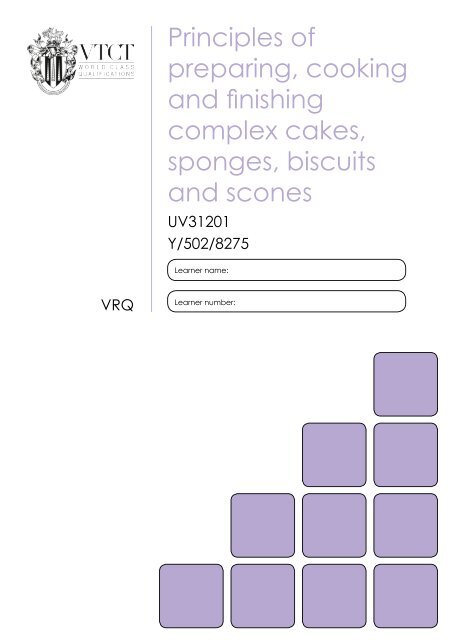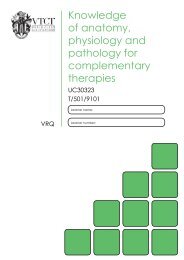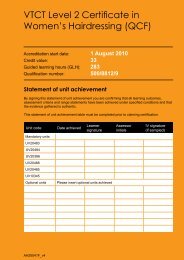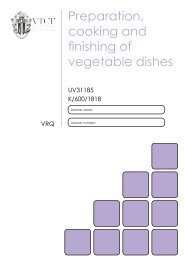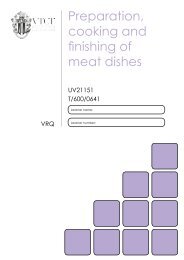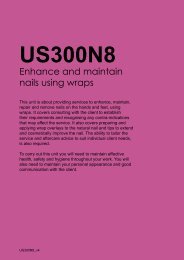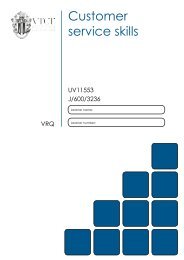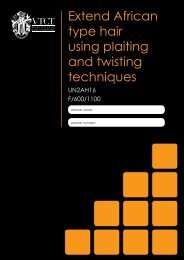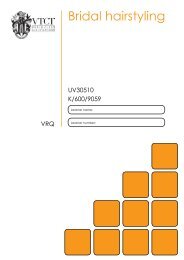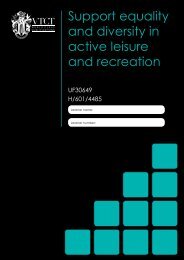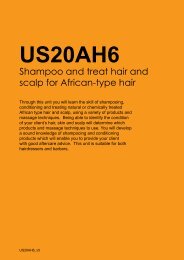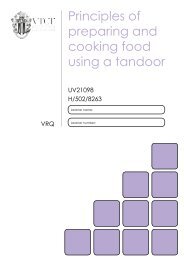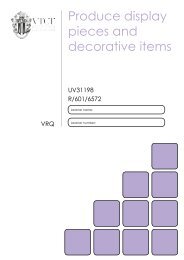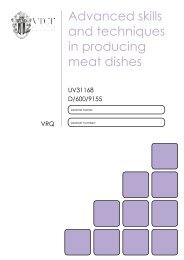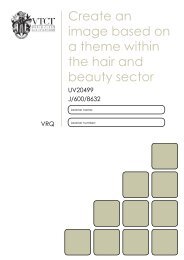Know how to finish complex cakes, sponges, biscuits and ... - VTCT
Know how to finish complex cakes, sponges, biscuits and ... - VTCT
Know how to finish complex cakes, sponges, biscuits and ... - VTCT
You also want an ePaper? Increase the reach of your titles
YUMPU automatically turns print PDFs into web optimized ePapers that Google loves.
VRQ<br />
Principles of<br />
preparing, cooking<br />
<strong>and</strong> <strong>finish</strong>ing<br />
<strong>complex</strong> <strong>cakes</strong>,<br />
<strong>sponges</strong>, <strong>biscuits</strong><br />
<strong>and</strong> scones<br />
UV31201<br />
Y/502/8275<br />
Learner name:<br />
Learner number:
Statement of unit achievement<br />
By signing this statement of unit achievement you are confirming that all learning outcomes, assessment<br />
criteria <strong>and</strong> range statements have been achieved under specified conditions <strong>and</strong> that the evidence<br />
gathered is authentic.<br />
This statement of unit achievement table must be completed prior <strong>to</strong> claiming certification.<br />
Unit code Date achieved Learner signature<br />
Assessor tracking table<br />
<strong>VTCT</strong> is the specialist awarding body for the Hairdressing, Beauty Therapy, Complementary Therapy,<br />
Hospitality <strong>and</strong> Catering <strong>and</strong> Sport <strong>and</strong> Active Leisure sec<strong>to</strong>rs, with over 50 years of experience.<br />
<strong>VTCT</strong> is an awarding body regulated by national organisations including Ofqual, SQA, DfES <strong>and</strong> CCEA.<br />
<strong>VTCT</strong> is a registered charity investing in education <strong>and</strong> skills but also giving <strong>to</strong> good causes in the area<br />
of facial disfigurement.<br />
Assessor name Assessor signature<br />
Assessor<br />
initials<br />
Assessors<br />
initials<br />
IV signature<br />
(if sampled)<br />
All assessors using this Record of Assessment book must complete this table. This is required for<br />
verification purposes.<br />
Assessor number<br />
(optional)
UV31201<br />
Principles of preparing, cooking<br />
<strong>and</strong> <strong>finish</strong>ing <strong>complex</strong> <strong>cakes</strong>,<br />
<strong>sponges</strong>, <strong>biscuits</strong> <strong>and</strong> scones<br />
The aim of this unit is <strong>to</strong> develop the knowledge <strong>and</strong><br />
underst<strong>and</strong>ing required <strong>to</strong> prepare, cook <strong>and</strong> <strong>finish</strong> <strong>complex</strong><br />
<strong>cakes</strong>, <strong>sponges</strong>, <strong>biscuits</strong> <strong>and</strong> scones including genoese,<br />
fruit <strong>cakes</strong>, fresh gateaux, chocolate <strong>to</strong>rte <strong>and</strong> hot plate<br />
scones. You will be taught the quality points of ingredients<br />
used <strong>and</strong> the effects of preparation <strong>and</strong> aeration methods<br />
on the end product.<br />
You will learn cooking methods <strong>and</strong> appropriate<br />
temperatures for cooking <strong>cakes</strong>, <strong>sponges</strong>, <strong>biscuits</strong> <strong>and</strong><br />
scones. You will also know <strong>how</strong> <strong>to</strong> <strong>finish</strong> <strong>and</strong> identify when<br />
they have the correct colour, flavour <strong>and</strong> texture. You will<br />
also be taught <strong>how</strong> <strong>to</strong> minimise common faults <strong>and</strong> avoid<br />
unecessary waste.<br />
UV31201_v6
Level<br />
Credit value<br />
GLH<br />
3<br />
2<br />
12<br />
Observation(s)<br />
0<br />
External paper(s)<br />
0
Principles of preparing, cooking<br />
<strong>and</strong> <strong>finish</strong>ing <strong>complex</strong> <strong>cakes</strong>,<br />
<strong>sponges</strong>, <strong>biscuits</strong> <strong>and</strong> scones<br />
Learning outcomes Evidence requirements<br />
On completion of this unit you will:<br />
1. <strong>Know</strong> <strong>how</strong> <strong>to</strong> prepare <strong>complex</strong> <strong>cakes</strong>,<br />
<strong>sponges</strong>, <strong>biscuits</strong> <strong>and</strong> scones<br />
2. <strong>Know</strong> <strong>how</strong> <strong>to</strong> cook <strong>complex</strong> <strong>cakes</strong>, <strong>sponges</strong>,<br />
<strong>biscuits</strong> <strong>and</strong> scones<br />
3. <strong>Know</strong> <strong>how</strong> <strong>to</strong> <strong>finish</strong> <strong>complex</strong> <strong>cakes</strong>,<br />
<strong>sponges</strong>, <strong>biscuits</strong> <strong>and</strong> scones<br />
1. <strong>Know</strong>ledge outcomes<br />
There must be evidence that you possess<br />
all the knowledge <strong>and</strong> underst<strong>and</strong>ing<br />
listed in the <strong>Know</strong>ledge section of this<br />
unit. In most cases this can be done<br />
by professional discussion <strong>and</strong>/or oral<br />
questioning. Other methods, such as<br />
projects, assignments <strong>and</strong>/or reflective<br />
accounts may also be used.<br />
2. Tu<strong>to</strong>r/Assessor guidance<br />
You will be guided by your tu<strong>to</strong>r/assessor<br />
on <strong>how</strong> <strong>to</strong> achieve learning outcomes in this<br />
unit. All outcomes must be achieved.<br />
3. External paper<br />
There is no external paper requirement for<br />
this unit.<br />
UV31201<br />
3
4<br />
Developing knowledge<br />
Achieving knowledge outcomes<br />
You will be guided by your tu<strong>to</strong>r <strong>and</strong> assessor<br />
on the evidence that needs <strong>to</strong> be produced.<br />
Your knowledge <strong>and</strong> underst<strong>and</strong>ing will be<br />
assessed using the assessment methods listed<br />
below*:<br />
• Projects<br />
• Observed work<br />
• Witness statements<br />
• Audio-visual media<br />
• Evidence of prior learning or attainment<br />
• Written questions<br />
• Oral questions<br />
• Assignments<br />
• Case studies<br />
• Professional discussion<br />
Where applicable your assessor will integrate<br />
knowledge outcomes in<strong>to</strong> practical observations<br />
through professional discussion <strong>and</strong>/or oral<br />
questioning.<br />
When a criterion has been orally questioned<br />
<strong>and</strong> achieved, your assessor will record this<br />
evidence in written form or by other appropriate<br />
means. There is no need for you <strong>to</strong> produce<br />
additional evidence as this criterion has already<br />
been achieved.<br />
Some knowledge <strong>and</strong> underst<strong>and</strong>ing outcomes<br />
may require you <strong>to</strong> s<strong>how</strong> that you know <strong>and</strong><br />
underst<strong>and</strong> <strong>how</strong> <strong>to</strong> do something. If you have<br />
practical evidence from your own work that<br />
meets knowledge criteria, then there is no<br />
requirement for you <strong>to</strong> be questioned again on<br />
the same <strong>to</strong>pic.<br />
*This is not an exhaustive list.<br />
UV31201
<strong>Know</strong>ledge<br />
Learning outcome 1<br />
<strong>Know</strong> <strong>how</strong> <strong>to</strong> prepare <strong>complex</strong> <strong>cakes</strong>, <strong>sponges</strong>, <strong>biscuits</strong> <strong>and</strong><br />
scones<br />
You can: Portfolio reference<br />
a. Describe the quality points in ingredients used for preparing<br />
<strong>complex</strong> <strong>cakes</strong>, <strong>sponges</strong>, <strong>biscuits</strong> <strong>and</strong> scones<br />
b. Describe corrective actions if there are quality problems with<br />
ingredients<br />
c. State the correct <strong>to</strong>ols <strong>and</strong> equipment <strong>to</strong> use when preparing<br />
<strong>complex</strong> <strong>cakes</strong>, <strong>sponges</strong>, <strong>biscuits</strong> <strong>and</strong> scones<br />
d. Explain the effects of various preparation <strong>and</strong> aeration methods on<br />
<strong>complex</strong> <strong>cakes</strong>, <strong>sponges</strong>, <strong>biscuits</strong> <strong>and</strong> scones<br />
e. Explain <strong>how</strong> the choice of fat <strong>and</strong> flour relates <strong>to</strong> the end product<br />
f. Describe preparation methods for <strong>complex</strong> <strong>cakes</strong>, <strong>sponges</strong>,<br />
<strong>biscuits</strong> <strong>and</strong> scones<br />
UV31201 5
6<br />
Learning outcome 2<br />
<strong>Know</strong> <strong>how</strong> <strong>to</strong> cook <strong>complex</strong> <strong>cakes</strong>, <strong>sponges</strong>, <strong>biscuits</strong> <strong>and</strong><br />
scones<br />
You can: Portfolio reference<br />
a. Describe cooking methods for different types of <strong>complex</strong> <strong>cakes</strong>,<br />
<strong>sponges</strong>, <strong>biscuits</strong> <strong>and</strong> scones<br />
b. State the temperatures for cooking <strong>complex</strong> <strong>cakes</strong>, <strong>sponges</strong>,<br />
<strong>biscuits</strong> <strong>and</strong> scones<br />
c. State healthy eating considerations when cooking <strong>complex</strong> <strong>cakes</strong>,<br />
<strong>sponges</strong>, <strong>biscuits</strong> <strong>and</strong> scones<br />
UV31201
Learning outcome 3<br />
<strong>Know</strong> <strong>how</strong> <strong>to</strong> <strong>finish</strong> <strong>complex</strong> <strong>cakes</strong>, <strong>sponges</strong>, <strong>biscuits</strong> <strong>and</strong><br />
scones<br />
You can: Portfolio reference<br />
a. Identify when <strong>complex</strong> <strong>cakes</strong>, <strong>sponges</strong>, <strong>biscuits</strong> <strong>and</strong> scones have<br />
the correct colour, flavour, texture <strong>and</strong> quantity<br />
b. Explain <strong>how</strong> <strong>to</strong> minimise common faults<br />
c. Explain <strong>how</strong> <strong>to</strong> control portions <strong>and</strong> minimise waste<br />
d. Describe <strong>finish</strong>ing methods for <strong>complex</strong> <strong>cakes</strong>, <strong>sponges</strong>, <strong>biscuits</strong><br />
<strong>and</strong> scones<br />
e. Explain <strong>how</strong> <strong>to</strong> s<strong>to</strong>re <strong>complex</strong> <strong>cakes</strong>, <strong>sponges</strong>, <strong>biscuits</strong> <strong>and</strong> scones<br />
UV31201 7
8<br />
Unit content<br />
This section provides guidance on the recommended knowledge <strong>and</strong> skills required <strong>to</strong> enable you<br />
<strong>to</strong> achieve each of the learning outcomes in this unit. Your tu<strong>to</strong>r/assessor will ensure you have the<br />
opportunity <strong>to</strong> cover all of the unit content.<br />
Outcome 1: <strong>Know</strong> <strong>how</strong> <strong>to</strong> prepare <strong>complex</strong> <strong>cakes</strong>, <strong>sponges</strong>, <strong>biscuits</strong> <strong>and</strong><br />
scones<br />
Complex <strong>cakes</strong>, <strong>sponges</strong>, <strong>biscuits</strong> <strong>and</strong><br />
scones: Genoese/light fatless, gateaux,<br />
Swiss roll, rich fruit cake, Dundee cake,<br />
jaconde sponge, sponge fingers, savarin,<br />
<strong>biscuits</strong> (sable, shortbread, tuilés, langue<br />
de chat), macaroons, chocolate <strong>to</strong>rte,<br />
scones, drop scones.<br />
Quality points: Appearance, colour,<br />
aroma, smell, texture, use-by date, no<br />
damage <strong>to</strong> packaging, no signs of pest<br />
infestation.<br />
Problems with ingredients: Quality of<br />
ingredients, incorrect order, out of date,<br />
mould, pests.<br />
Corrective actions: Reporting <strong>to</strong><br />
supervisor, advising colleagues, seeking<br />
advice for appropriate person, contacting<br />
suppliers, returning problem ingredients<br />
<strong>to</strong> suppliers, using alternatives, ensuring<br />
problem ingredients are not used,<br />
disposing of problem ingredients, correct<br />
s<strong>to</strong>rage.<br />
Correct <strong>to</strong>ols <strong>and</strong> equipment: Small<br />
equipment, bowls, spoons, cake tins,<br />
scrapers, spatulas, plain cutters, fluted<br />
cutters, piping bags, plain nozzles, fluted<br />
nozzles, moulds, whisks, palette knife,<br />
mixers, oven, measuring jugs, sieves,<br />
scales.<br />
Preparation methods: Weighing,<br />
measuring, creaming, beating, whisking,<br />
folding, rubbing in, greasing, glazing,<br />
portioning, piping, shaping, filling,<br />
rolling, lining, trimming, icing, spreading,<br />
smoothing, kneading, proving, dusting,<br />
UV31201<br />
sprinkling, mixing, coating, stacking,<br />
slicing, baking.<br />
Various preparation <strong>and</strong> aeration<br />
methods: Lightness, aeration, correct<br />
consistency, correct texture, even colour of<br />
cooked product.<br />
Choice of fat <strong>and</strong> flour relates <strong>to</strong> the<br />
end product: Finished texture, fine<br />
texture, shortness, flavour, cost of product,<br />
aeration, increased fibre (wholemeal flour).<br />
Preparation methods: Weighing,<br />
measuring, creaming, beating, whisking,<br />
folding, rubbing in, greasing, glazing,<br />
portioning, piping, shaping, filling,<br />
rolling, lining, trimming, icing, spreading,<br />
smoothing, kneading, proving, dusting,<br />
sprinkling, mixing, coating, stacking, slicing,<br />
baking.
Outcome 2: <strong>Know</strong> <strong>how</strong> <strong>to</strong> cook <strong>complex</strong> <strong>cakes</strong>, <strong>sponges</strong>, <strong>biscuits</strong> <strong>and</strong><br />
scones<br />
Cooking methods: Baking, frying,<br />
steaming.<br />
Temperatures for cooking: Rich fruit <strong>cakes</strong><br />
170°C, small sponge <strong>cakes</strong>, fairy <strong>cakes</strong>,<br />
Swiss roll 180°C, cake batters approximately<br />
155°C, <strong>biscuits</strong> <strong>and</strong> scones 180-200°C.<br />
Healthy eating considerations: Increasing<br />
fibre content, substituting saturated fats, less<br />
sugar, less salt, using alternatives <strong>to</strong> double<br />
cream, portion control.<br />
Outcome 3: <strong>Know</strong> <strong>how</strong> <strong>to</strong> <strong>finish</strong> <strong>complex</strong> <strong>cakes</strong>, <strong>sponges</strong>, <strong>biscuits</strong> <strong>and</strong><br />
scones<br />
Correct colour, flavour, texture <strong>and</strong><br />
quantity: Follow recipe, check dish<br />
specification, refer <strong>to</strong> dish specification<br />
pho<strong>to</strong>graph, check colour, texture, crumb<br />
texture, crust, aroma, flavour.<br />
Common faults: Incorrect texture, sinking,<br />
peaking, sinking fruit.<br />
Minimise common faults: Follow<br />
recipe, check dish specification, refer<br />
<strong>to</strong> dish specification pho<strong>to</strong>graph, use<br />
fresh ingredients, use quality ingredients,<br />
use correct equipment, use equipment<br />
correctly, ensure preparation <strong>and</strong> cooking<br />
times are correct.<br />
Control portions <strong>and</strong> minimise waste:<br />
Appropriate portion sizes, staff training,<br />
marking portions, cutting accurately, using<br />
correct equipment, weighing accurate<br />
amounts, <strong>finish</strong>ing <strong>to</strong> order, keeping at<br />
correct temperature.<br />
Finishing methods: Filling, decorating,<br />
rolling, trimming, icing, spreading,<br />
smoothing, dusting, dredging, sprinkling,<br />
piping, glazing, portioning, stacking.<br />
S<strong>to</strong>rage: Cooked products unfilled (air<br />
tight conditions, air tight containers, cool<br />
dry place), filled products containing high<br />
risk foods (refrigera<strong>to</strong>r, below 5°C, avoiding<br />
cross-contamination, ensuring food safety)<br />
covered, labelled, dated.<br />
UV31201 9
10<br />
UV31201<br />
Notes<br />
Use this area for notes <strong>and</strong> diagrams


